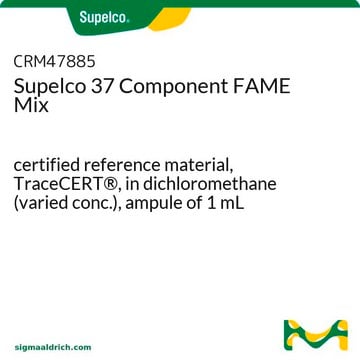If this product has an expiration or retest date, it will be shown on the Certificate of Analysis (COA, CofA). If there is no retest or expiration date listed on the product's COA, we do not have suitable stability data to determine a shelf life. For these products, the only date on the COA will be the release date; a retest, expiration, or use-by-date will not be displayed.
For all products, we recommend handling per defined conditions as printed in our product literature and website product descriptions. We recommend that products should be routinely inspected by customers to ensure they perform as expected.
For products without retest or expiration dates, our standard warranty of 1 year from the date of shipment is applicable.
For more information, please refer to the Product Dating Information document: https://www.sigmaaldrich.com/deepweb/assets/sigmaaldrich/marketing/global/documents/449/386/product-dating-information-mk.pdf
A3611
Arachidonic acid
from non-animal source, ≥98.5% (GC)
Sinónimos:
cis,cis,cis,cis-5,8,11,14-Eicosatetraenoic acid, Eicosa-5Z,8Z,11Z,14Z-tetraenoic acid, Immunocytophyte
About This Item
Productos recomendados
origen biológico
non-animal source
Nivel de calidad
Ensayo
≥98.5% (GC)
Formulario
liquid
índice de refracción
n20/D 1.4872 (lit.)
bp
169-171 °C/0.15 mmHg (lit.)
mp
−49 °C (lit.)
densidad
0.922 g/mL at 25 °C (lit.)
grupo funcional
carboxylic acid
tipo de lípido
omega FAs
Condiciones de envío
dry ice
temp. de almacenamiento
−20°C
cadena SMILES
OC(CCC/C=C\C/C=C\C/C=C\C/C=C\CCCCC)=O
InChI
1S/C20H32O2/c1-2-3-4-5-6-7-8-9-10-11-12-13-14-15-16-17-18-19-20(21)22/h6-7,9-10,12-13,15-16H,2-5,8,11,14,17-19H2,1H3,(H,21,22)/b7-6-,10-9-,13-12-,16-15-
Clave InChI
YZXBAPSDXZZRGB-DOFZRALJSA-N
¿Está buscando productos similares? Visita Guía de comparación de productos
Aplicación
<li><strong>Molecular Mechanisms Associated with the Inhibitory Role of Long Chain n-3 PUFA in Colorectal Cancer:</strong> This study discusses the effects of long-chain polyunsaturated fatty acids, like arachidonic acid, on colorectal cancer mechanisms. The research focuses on the anti-inflammatory and cancer inhibitory roles through the modulation of lipid metabolism and signal transduction pathways (Jayathilake et al., 2024).</li>
<li><strong>Zhilining Formula alleviates DSS-induced colitis through suppressing inflammation and gut barrier dysfunction via the AHR/NF-Bp65 axis:</strong> This article presents arachidonic acid′s role in the suppression of inflammation and restoration of gut barrier function, crucial for understanding inflammatory diseases and developing therapeutic strategies (Zhou et al., 2024).</li>
<li><strong>5,6-diHETE lactone (EPA-L) mediates hypertensive microvascular dilation by activating the endothelial GPR-PLC-IP(3) signaling pathway:</strong> Explores the cardiovascular implications of arachidonic acid metabolites, specifically their role in microvascular responses, which could influence hypertension treatment strategies (Asulin et al., 2024).</li>
</ul>
Acciones bioquímicas o fisiológicas
Envase
Palabra de señalización
Warning
Frases de peligro
Consejos de prudencia
Clasificaciones de peligro
Eye Irrit. 2 - Skin Irrit. 2
Código de clase de almacenamiento
10 - Combustible liquids
Clase de riesgo para el agua (WGK)
WGK 3
Punto de inflamabilidad (°F)
235.4 °F - closed cup
Punto de inflamabilidad (°C)
113 °C - closed cup
Elija entre una de las versiones más recientes:
Certificados de análisis (COA)
¿No ve la versión correcta?
Si necesita una versión concreta, puede buscar un certificado específico por el número de lote.
¿Ya tiene este producto?
Encuentre la documentación para los productos que ha comprado recientemente en la Biblioteca de documentos.
Los clientes también vieron
-
How can I determine the shelf life / expiration / retest date of this product?
1 answer-
Helpful?
-
-
How is shipping temperature determined? And how is it related to the product storage temperature?
1 answer-
Products may be shipped at a different temperature than the recommended long-term storage temperature. If the product quality is sensitive to short-term exposure to conditions other than the recommended long-term storage, it will be shipped on wet or dry-ice. If the product quality is NOT affected by short-term exposure to conditions other than the recommended long-term storage, it will be shipped at ambient temperature. As shipping routes are configured for minimum transit times, shipping at ambient temperature helps control shipping costs for our customers. For more information, please refer to the Storage and Transport Conditions document: https://www.sigmaaldrich.com/deepweb/assets/sigmaaldrich/marketing/global/documents/316/622/storage-transport-conditions-mk.pdf
Helpful?
-
-
What is the solubility of item A3611, Arachidonic acid?
1 answer-
This product is soluble in DMSO (100 mg/ml), DMF (100 mg/ml), 100% ethanol (50 mg/ml), methanol (50 mg/ml), chloroform (50 mg/ml), dichloromethane, hexane, acetonitrile, and ether.
Helpful?
-
-
what is the volume in the 10mg ampule for A3611- arachidonic acid?
1 answer-
Based on the density of 0.922 g/mL, the volume of the 10 mg package is approximately 0.011mL.
Helpful?
-
-
What is the volume in microL of arachidonic acid (A3611-100 mg) in vial? Please specify the purity (PCode 1003455023).
1 answer-
There is 108 uL in the 100mG pack size. The exact purity will be listed on the Certificate of Analysis. Please see the sample Certificate of Analysis: https://www.sigmaaldrich.com/certificates/sapfs/PROD/sap/certificate_pdfs/COFA/Q14/A3611-1G-PWSLCQ3577.pdf
Helpful?
-
-
May I know the Molarity (M) of the Arachidonic Acid A3611? It was not stated in the SDS.
1 answer-
The concentration for this product will be lot specific as purity changes with each batch. The concentration of this material can be calculated by the following equation: density x 1000 x purity percent divided by the molecular weight. For example, lot SLCQ3577 on the sample certificate of analysis will have a concentration of about 3.01 M
Helpful?
-
-
Hi, I'm used to ordering AA with this same catalogue nr at 10mg in powder form. Now only 100mg in liquid form is available. In which solvent is this?
1 answer-
This is pure arachadonic acid - it is not in any solvent. Its melting point is at -49 deg C. At temperatures above, it will be in its liquid physical state. You can determine the amount by using the density for a calculation. 0.922 g/mL at 25 °C (lit.)
Helpful?
-
Active Filters
Nuestro equipo de científicos tiene experiencia en todas las áreas de investigación: Ciencias de la vida, Ciencia de los materiales, Síntesis química, Cromatografía, Analítica y muchas otras.
Póngase en contacto con el Servicio técnico









